Thriving Through Winter: Essential California Lawn Care Tips

A Guide to Winter Lawn Care in California
Maintaining a lush, vibrant lawn in California demands a tailored approach, especially during the cooler winter months. As the seasons shift and temperatures drop, your lawn's needs evolve, requiring specific care strategies to ensure its health and resilience against the seasonal challenges unique to the region.
This comprehensive guide serves as a roadmap for California residents, offering insights and practical tips to navigate winter lawn care effectively. From adjusting mowing practices to soil enhancement techniques, pest management, and more, this guide empowers you to safeguard your lawn's vitality amidst the winter chill.
Discover how to protect against common winter issues, encourage healthy root growth, and adapt irrigation schedules to conserve water without compromising your lawn's health. Whether you're facing mushy grass and invasive weeds or seeking ways to fortify your lawn for the upcoming spring, this guide equips you with the knowledge and strategies necessary to nurture a resilient and thriving lawn throughout the winter season.
Adjusted Mowing Frequency for Winter
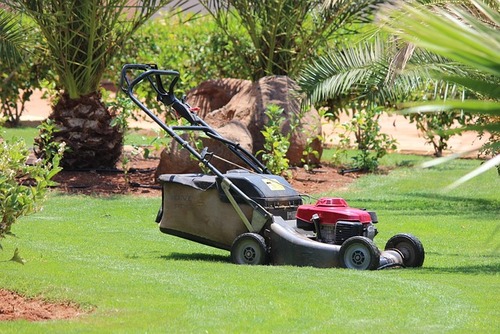
A Push-Mower on a Freshly Cut Lawn - Image by kikatani on Pixabay
In the winter, your lawn's growth slows down significantly. Consequently, your mowing frequency can be reduced from the usual weekly routine to once or twice a month. This adjustment helps prevent stress on the grass while maintaining an adequate height.
Raising Mowing Height
As winter approaches and grass prepares for dormancy, adjust your mowing practices by readjusting your mower blade. Allow your lawn to grow slightly taller, aiming for a height between 3 to 4 inches. This strategic adjustment helps protect the crowns of grass plants from the harsh effects of cold weather.
Benefits of Taller Grass
Longer grass blades provide increased insulation, safeguarding the delicate crowns and root systems from potential frost damage. Additionally, taller grass captures more sunlight, aiding in photosynthesis and nutrient storage crucial for winter survival.
Gradual Transition
Start gradually raising the mowing height a few weeks before winter sets in. Avoid abrupt changes in mowing height to prevent stressing the grass, allowing it to acclimate gradually to the taller length.
Maintaining Proper Technique
Despite the increased height, adhere to best mowing practices. Ensure your mower blade remains sharp to achieve clean cuts, preventing grass damage. Avoid mowing wet grass as it can lead to clumping and potential lawn diseases.
Additional Information: Leaving grass clippings on the lawn aids in moisture retention and supplies essential nutrients, acting as a natural fertilizer. Consider using a mulching mower to finely chop grass clippings, promoting quick decomposition.
Soil Enhancement for Winter Resilience

A Garden Spade Digs into a Bed of Soil - Image by walkersalmanac on Pixabay
Winter offers an opportune time to revamp your soil structure for optimal grass growth. Aim for loamy soil, ideal for accommodating various grass types. Testing your soil's pH using a home test kit or consulting a local cooperative extension allows you to fine-tune pH levels using suitable additives like organic fertilizers or compost.
Understanding Soil Composition
Soil serves as the foundation for a healthy lawn. Winter presents an excellent opportunity to improve soil structure, fostering an environment conducive to robust grass growth. Understanding your soil composition is essential for effective enhancement.
Soil Testing and pH Adjustment
Conduct soil tests using a home kit or seek assistance from your local cooperative extension to determine pH levels and soil composition. Adjust pH levels as necessary using amendments like lime to raise pH or elemental sulfur to lower it, ensuring an optimal pH range for healthy grass growth.
Incorporating Organic Matter
Enhance soil fertility by adding organic matter such as compost, aged manure, or organic fertilizers. These amendments improve soil structure, increase water retention, and encourage beneficial microbial activity, fostering a more fertile environment for your lawn.
Winter Fertilization for Cool-Season Grasses
Consider applying a slow-release fertilizer formulated for winter application, especially for cool-season grasses like fescue or ryegrass. This practice supplies essential nutrients that support winter resilience, aiding in stronger root development and overall grass health.
Mulching and Soil Protection
Apply a layer of mulch to garden beds or around trees to protect soil from erosion and temperature fluctuations during winter. Mulch conserves moisture, insulates roots, and gradually decomposes, enriching the soil with organic matter.
Consistent Soil Care
Make soil enhancement a consistent part of your lawn care regimen. Regularly adding organic matter, conducting soil tests, and adjusting pH levels helps maintain a balanced and nutrient-rich soil profile, ensuring long-term lawn health.
Observation and Adaptation
Observe your lawn's response to soil enhancements and adjust your approach based on grass health, drainage improvements, and overall soil quality. Customizing soil enhancement practices according to your lawn's specific needs ensures optimal results.
Additional Information: Cool-season grasses such as fescue, ryegrass, and bluegrass thrive with winter fertilization. This practice fortifies their resilience against the colder temperatures, ensuring a lush green lawn come springtime.
Protecting Against Winter Pests
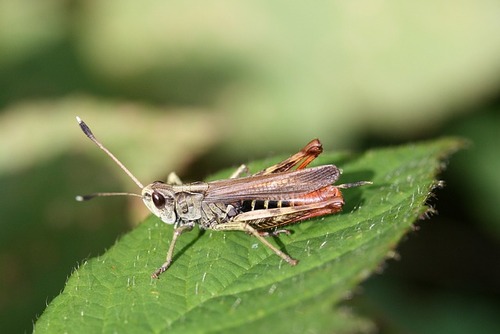
A Grasshopper Rests on a Green Leaf - Image by Siegella on Pixabay
Winter brings its own set of pests that thrive in moist and low-cut grass. Ensure your lawn isn't excessively wet, and avoid cutting the grass too short to prevent infestation. Employing insecticides or natural remedies acts as a preventive measure against potential infestations.
Utilizing Dormant Spray Oils
Incorporating dormant spray oils, particularly on fruit trees and select shrubs, serves as an effective method to manage overwintering soft-bodied insect pests and their eggs. These oils act by smothering and suffocating dormant pests, preventing their emergence and infestation in the coming seasons.
Application Techniques
Apply dormant spray oils during the dormant period of trees and shrubs, typically in late winter or early spring before bud break. Ensure thorough coverage of branches, twigs, and trunk surfaces as well as the underside of leaves where pests might hide.
Choosing the Right Oils
Select horticultural oils designed for dormant use, following manufacturer instructions for application rates and timing. These oils are often safe for beneficial insects and the environment when used correctly.
Benefits of Dormant Sprays
Apart from controlling overwintering pests, dormant sprays aid in reducing pest populations, thereby potentially minimizing the need for stronger chemical treatments during the active growing season. They serve as a preventive measure, curbing pest damage before it becomes a significant issue.
Additional Information: Encourage natural pest controllers like birds and beneficial insects by incorporating bird feeders or insect-friendly plants in your garden. This natural ecosystem fosters a balance that aids in pest control without resorting to chemical solutions.
Vital Aeration for Healthy Roots
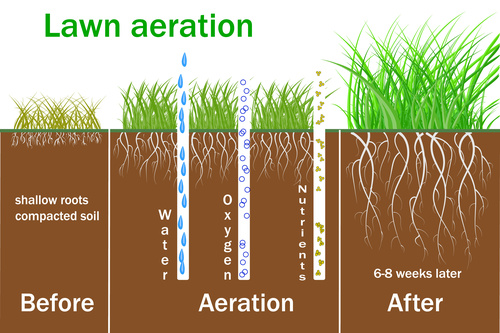
A Diagram Illustrating How Lawn Aeration Works
Aeration is a crucial practice, especially for clay soil, as it allows oxygen, water, and nutrients to penetrate the soil, promoting healthy root growth. Compacted soil restricts root development and inhibits the uptake of essential elements.
Understanding the Importance of Aeration
Aeration is a fundamental practice for maintaining healthy soil structure and promoting robust root growth. In winter, when soil might become compacted due to foot traffic or previous seasonal conditions, aeration becomes even more crucial.
Aeration Techniques
Consider using a core aerator or aeration shoes to perforate the soil, creating channels that allow air, water, and nutrients to penetrate deeply. Focus on areas where soil compaction is prominent or where water tends to puddle, as these regions benefit most from improved aeration.
Timing for Winter Aeration
Winter, with its moderate soil moisture levels, provides an optimal opportunity for aeration. Performing this task during the dormant season allows the soil to recover and prepares it for vigorous growth when spring arrives.
Enhancing Soil Structure
Aeration aids in breaking up compacted soil, preventing it from suffocating roots and restricting nutrient uptake. The process also encourages the decomposition of thatch, allowing it to break down naturally and nourish the soil.
Overseeding After Aeration
Following aeration, consider overseeding your lawn. The aeration holes provide an excellent environment for new grass seeds to establish themselves, resulting in a denser and more resilient lawn.
Benefits Beyond Winter
Improved soil aeration translates into long-term benefits for your lawn's health. It fosters deeper root systems, enabling better water absorption and nutrient uptake, leading to a more drought-resistant and vigorous lawn throughout the year.
Consistency in Aeration
Make aeration a regular part of your lawn care routine, aiming to aerate at least once a year, especially if your soil tends to compact easily. Consistent aeration helps maintain healthy soil structure and promotes continuous root growth.
Additional Information: Following aeration, overseeding with appropriate grass seeds helps thicken the lawn, filling in bare patches and ensuring a lush green carpet when spring arrives.
Adjusting Irrigation for California's Winter
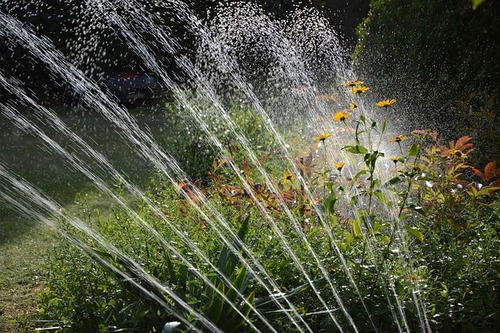
A Lawn Sprinkler Sprays Over Greenery - Image by PeggyChoucair on Pixabay
California's winters often bring increased rainfall, altering the irrigation needs for lawns and plants. Understanding and adjusting your irrigation schedule is crucial to prevent overwatering and maintain a healthy lawn during this season.
Understanding Winter Watering Needs
As rainfall becomes more frequent, lawns and plants naturally receive more moisture from the environment. This shift reduces the necessity for frequent irrigation. Overwatering during winter not only wastes water but also poses risks of fungal diseases and root rot, compromising the health of your lawn and plants.
Tips for Setting Irrigation Controllers
- Reduce Frequency: Modify your irrigation system to accommodate the decrease in watering needs. Adjust the controller to water less frequently but deeply. Instead of shorter, more frequent watering sessions, opt for longer and less frequent intervals to allow water to penetrate deeper into the soil.
- Check Weather Forecasts: Utilize weather-based smart controllers or manually adjust the system based on upcoming weather forecasts. Skip watering cycles if rain is predicted, allowing natural rainfall to nourish your lawn.
- Consider Morning Watering: Schedule irrigation sessions during the morning hours. This timing helps reduce water loss due to evaporation and allows the grass and plants to dry off during the day, minimizing the risk of fungal growth.
- Monitor Soil Moisture: Invest in moisture sensors or manually check the soil's moisture level. Adjust your irrigation schedule based on the actual moisture needs of your lawn and plants rather than relying solely on a preset schedule.
- Inspect Sprinklers: Regularly check and maintain sprinkler heads for proper functionality. Adjust their direction and coverage to ensure uniform watering without wastage.
Importance of Adjusting Irrigation
Adapting your irrigation schedule during winter is pivotal in maintaining a healthy lawn and conserving water. Overwatering not only leads to unnecessary resource depletion but also invites potential problems like mold, fungus, and weakened root systems.
Seeking Professional Assistance
Implementing these comprehensive winter lawn care tips significantly contributes to maintaining the vitality of your lawn during the colder months. To further enhance your lawn's health and address specific needs, consider seeking professional assistance from local landscaping experts.
If you reside in the San Francisco Bay Area, Arborist Now stands ready to assist you in nurturing a flourishing lawn this winter. Our expertise and tailored solutions can provide invaluable support in ensuring your lawn stays healthy and vibrant throughout the winter season.
Conclusion
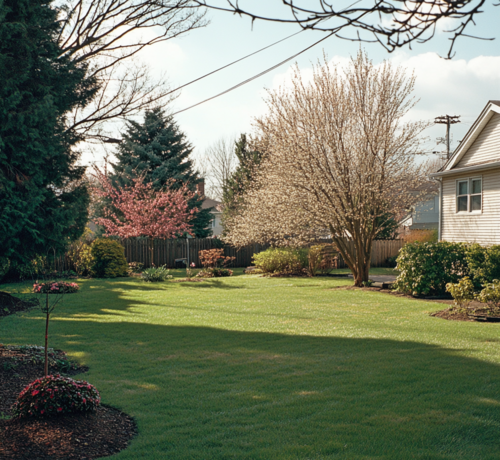
Early Spring Landscaping: A Tidy Suburban Lawn With Blooming Trees
As winter bids farewell and the promise of spring looms, your efforts in nurturing your California lawn through the colder months pave the way for a vibrant and resilient landscape. This guide has provided a spectrum of insights and actionable strategies tailored to California's unique climate, empowering you to fortify your lawn against winter trials.
From adjusting mowing heights to soil enrichment, pest management, and thoughtful irrigation practices, you've discovered the tools to foster a healthier lawn. Strategies to combat mushy grass, tackle invasive weeds, and enhance soil quality have equipped you with a holistic approach to winter lawn care.
Remember, consistent care and observation are paramount. Monitoring your lawn's response to these practices allows for adaptation and refinement, ensuring ongoing success. As you implement these techniques, you not only nurture a greener, lusher lawn but also contribute to sustainable and environmentally conscious practices.
As the seasons transition, your dedication to winter lawn care lays the groundwork for a robust, thriving lawn that will greet the spring with vigor. Embrace these insights, adapt them to your lawn's specific needs, and witness the rewards of a resilient California lawn that flourishes year-round.
Originally posted on January 10, 2020





